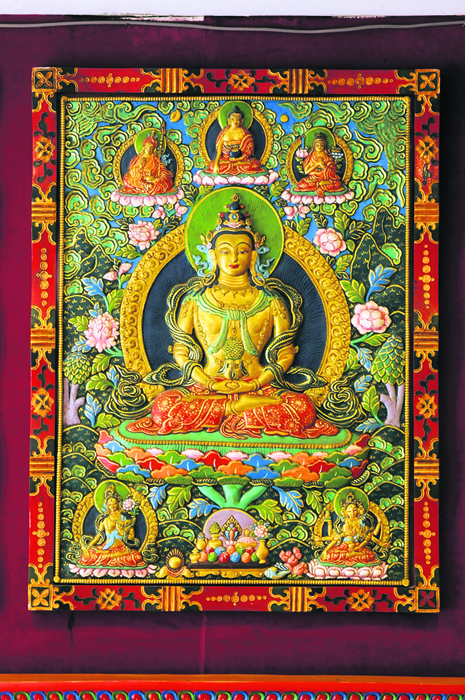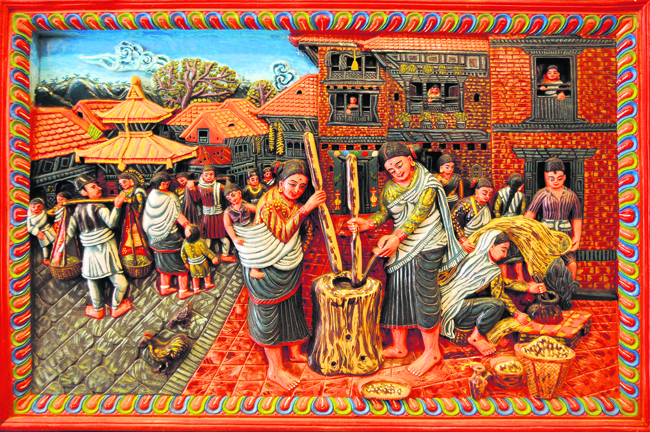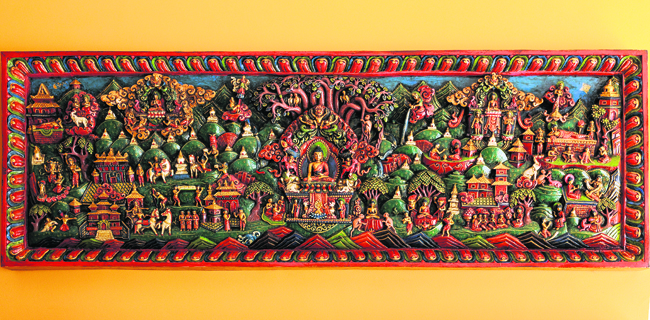
OR

It was around 20 years ago that he came up with an idea for a business but it has just been five years that his dreams turned into a reality. It took 63-year-old Swayambhu Dhakwa 15 years to get his store Art Decor up and running at Kupondole. Now, he sells artworks based on Tibetan, Newari and Nepali traditional and religious themes. He collects and, in some cases, carves an original masterpiece of different kinds of art so that he can make more replicas. An artist himself, this week he joins us to talk about his journey and everything he wishes to achieve through the endeavor.
Starting out
Dhakwa trained himself on art. Nobody taught him anything remotely related to art. He used to enjoy drawing immensely and as he got drawn into his passion, he started exploring his talents and generating ideas. He spent 18 years honing his skills, creating art that ranged from drawings to crystal statues. He recalls making statues and other handicrafts after months and, sometimes, even a year of hard work. Someone would then come along and buy it and if he ever needed another of the same thing, he would have to start all over again. To address this issue, he decided he would make a rubber molding for all of his handicraft works. This was at a time when the concept of rubber molding was just coming up.
“You can’t open a shop with just one or two of these carvings, replicas or not,” he said. So when he had more than 150 molds ready, he decided it was time to get a move on. This endeavor of his wouldn’t just take up a small place. He needed enough space to fill the mold, let it dry and then have to move it to a place where it could be painted at a comfortable, leisurely pace. Therefore, he bought a small piece of land and made a house so that neither he nor his children would need to think about the overhead costs of renting a place. “I always thank god for giving me this foresight,” he revealed. Business hasn’t picked up enough for them to be able to afford the rent at such a location.
Most people are afraid to even enter the shop located at Kopundol, opposite Nabil bank. “Many times I see people looking at the display all interested, and then they turn away, wary of the price,” he said, laughing. Little do these unsuspecting people know that the prices in the shop range from Rs 1000 to Rs 50,000. When someone does enter the shop, he claims that their expressions are priceless when they see realize the difference between the prices they were expecting and what these artwork are marked at.
When people think of handicraft, most think it’s only meant for tourists and that it’s too expensive for them to be able to afford a good piece. Dhakwa came up with the concept of art decor because he wanted Nepalis to benefit from the beauty of these artworks as well. Initially he thought he would only sell to Nepalis people, but he later came to see that most of his clients were Chinese. His main target, he says, is that when someone constructs or reconstructs a house, at least one of their decorative pieces for their new place should be from his Art Decor. If just one person likes and buys his work, word will spread to their friends and family member thus creating a chain reaction.
Family first
“I think the idea of running a family business initially entered my mind when my cousin’s daughter went abroad,” Dhakwa revealed. In the 45 years she has been in the UK she has visited only four times. She wasn’t here when her parents fell sick and eventually passed away, and nor were she or her husband here when her in-laws fell sick and passed away too. He found it really disheartening and knew the he wouldn’t ever encourage his children to go away like that. Lucky for him, his children didn’t want to go away either. He reveals that there were many suitors living abroad who approached him for his girls’ hands in marriage but he never accepted any of these proposals.
Too many people go abroad in the search of a better life. He knew that if his children had a good life here, they wouldn’t need to be thinking about the grass being greener halfway across the world. His daughters are now married and live close by and the shop also acts as a way to bring the entire family together every single day.
“My eldest daughter has children so she comes to work after she sends them to school. My youngest is the only daughter-in-law and has to manage all the household chores by herself so she only comes in during the day,” he said as he explained what their schedules look like. He sometimes stays at the shop and sends his daughters home to be with their mother instead. In a culture where after marriage women going back to their parents house all the time is generally frowned upon, he is content to have a reason to see them every day. His son, who has another shop near the Patan Durbar Square, comes to during closing time.
“Although all three of my kids have master’s degrees, I have never wanted them to work for somebody else,” Dhakwa said. “The workforce is not always the greatest place, especially for girls, so I wanted to do something for them,” he added. Thus, the profits are divided equally among his children, with each of them getting 33 percent. Since he owns the place, he has rented it out and lives off the rent he collects form several organizations that have their offices in the building. He is very happy with this arrangement as his daughters don’t have to depend on anyone for their personal spending, or stress out about a rigid job they might not even like, all the while keeping his family close together.
Challenges
“Most people are content with admiring the shop from afar and are afraid to step into the shop. This is one of the most challenging things about this business,” Dhakwa revealed. The location, the kind of items on display all act as deterring factors for most people. Before the earthquake, business had started to pick up due to the apartment culture that had taken over Kathmandu. A lot of people living in such close proximity meant that if one purchased a piece of work, others were bound to know about it and look for something themselves. Now that people are too scared to do so, business from individual households has slowed down again.
“Various organizations heard about what we do here at Art Decor and have started placing bulk orders for gifts. When high-ranking officials come for official visits, we usually receives an order for an artwork,” said Dhakwa.
He has never sold a single replica claiming it to be the real deal, however, he talked about a few people who purchased his replicas and sold them at more than five times the amount by claiming it to be real. “Most of these people do this abroad as a onetime thing to make huge profits,” he explained.
The artworks
Dhakwa laughed as he pointed out a few masterpieces he had in the shop, claiming that people looking to decorate wouldn’t even look at the original piece standing amongst their midst. The scribe too can attest to that claim – the original pieces he pointed out didn’t make much of an impression amongst its colorful and vibrant replicas. Only a collector, like himself, would buy a handmade artwork in copper.
Stone dust filling combined with hardening chemicals make these replicas so strong that even when he hammered at one with all his might, it didn’t cause a single crack. “There are replicas out there that have been created with plaster of Paris and these replicas that are very fragile,” Dhakwa explained. Acrylic paint with lacquer sprayed as a topcoat protects these artwork from environmental damage.
Painted wooden box with statues
These statues were originally meant to go into “khopas” in the traditional build of the house. But since they are no longer around, he has put the statues into these khopa shaped boxes as symbolic representations.
Thangka style
 When people think of Thangka, they only think of painting done in pieces of cloths. These Thangka like sculptures are his attempts to bring the paintings to life and make it accessible for all. And they aren’t even as expensive as Thangka paintings generally are.
When people think of Thangka, they only think of painting done in pieces of cloths. These Thangka like sculptures are his attempts to bring the paintings to life and make it accessible for all. And they aren’t even as expensive as Thangka paintings generally are.
Newar lifestyle
 With modernization, our culture too is slowly dying. It is hard to see someone wearing a hakupatasi or somebody walking around with a kharpan (two baskets on each side of a bamboo stick carried over the shoulder). With the Newar themed artworks inspired by the paintings of Hari Prasad Rimal, Dhakwa wants to keep the culture alive.
With modernization, our culture too is slowly dying. It is hard to see someone wearing a hakupatasi or somebody walking around with a kharpan (two baskets on each side of a bamboo stick carried over the shoulder). With the Newar themed artworks inspired by the paintings of Hari Prasad Rimal, Dhakwa wants to keep the culture alive.
Mandala
 Most people, moving into their new houses, look to decorate their space with the Mandala. It is a symbol that represents the universe and shows how people attain nirvana. All the stupas, if you look from a bird’s eye view, look like a mandala as well, with its fire, earth, water, and sky elements.
Most people, moving into their new houses, look to decorate their space with the Mandala. It is a symbol that represents the universe and shows how people attain nirvana. All the stupas, if you look from a bird’s eye view, look like a mandala as well, with its fire, earth, water, and sky elements.
Buddha’s life
 His personal favorite work, this artwork covers the entire lifecycle of Gautam Buddha, from birth to death. The original artwork for this piece is kept at Dhakwa’s house.
His personal favorite work, this artwork covers the entire lifecycle of Gautam Buddha, from birth to death. The original artwork for this piece is kept at Dhakwa’s house.
You May Like This

HBO hacked: 'Game Of Thrones' S7 episodes may leak online
LOS ANGELES, August 1: HBO has once again become a victim of cyber attack as the network's upcoming episodes of a... Read More...

Game of Thrones to end with season 8
LOS ANGELES, Jul 31: Winter is finally set to bid goodbye to "Game of Throne" as HBO has confirmed the... Read More...





Just In
- MoHP cautions docs working in govt hospitals not to work in private ones
- Over 400,000 tourists visited Mustang by road last year
- 19 hydropower projects to be showcased at investment summit
- Global oil and gold prices surge as Israel retaliates against Iran
- Sajha Yatayat cancels CEO appointment process for lack of candidates
- Govt padlocks Nepal Scouts’ property illegally occupied by NC lawmaker Deepak Khadka
- FWEAN meets with President Paudel to solicit support for women entrepreneurship
- Koshi provincial assembly passes resolution motion calling for special session by majority votes






_20220508065243.jpg)






Leave A Comment